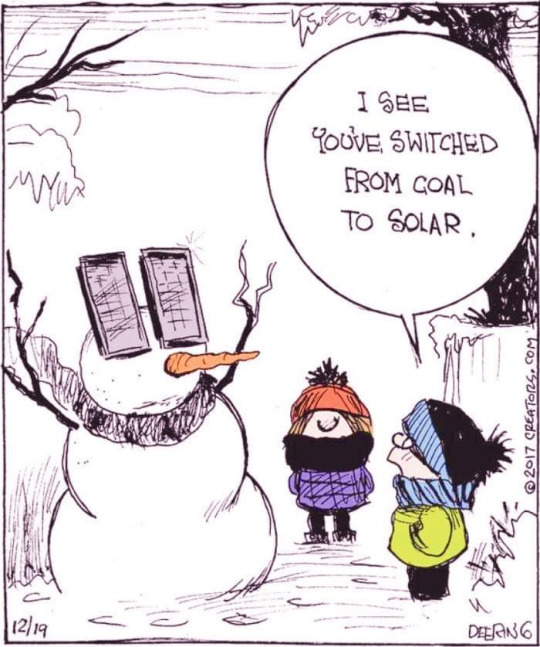deign -verb 1. to think fit or in accordance with one's dignity. 2. to condescend to give or grant. design -verb 1. to plan and fashion artistically or skillfully. 2. to intend for a definite purpose. 3. to form or conceive in the mind; contrive. ----------------------------------------------- my tweets my photos -----------------------------------------------
Don't wanna be here? Send us removal request.
Text
youtube
Zipline's method for making deliveries to hospitals in Rwanda is so cool.
1 note
·
View note
Text
I really enjoyed this movie. Big recommend. Had the opportunity to see it on a barge floating off the coast of Red Hook Brooklyn. Thanks to RETI Center for hosting the event.
youtube
1 note
·
View note
Text
youtube
Check this 13 min movie on AgriPV from NCAT.
It's packed with great info.
link to their website for agriPV resources

0 notes
Text
They split up the light and gave some wavelengths to the plants and some to the PV !
Pretty neat innovation for agrivoltaics.

Article:
0 notes
Text

LPO at the DOE brining some of that 1930s / 1940s WPA poster vibe.
Check the new VPP report here:
link to the full LPO pdf here
0 notes
Text
vimeo
I just learned about Swale, a utopian idea for a dystopic time.
"Swale utilizes marine common law in order to be public yet circumvent local public land-based laws."
So cool. Another great example of Regulatory Disobedience.
You can check out the Swale Lab in the Swale House on Governors Island through the end of October.
Project website
Artist link
thanks to ABC for telling me about Swale
1 note
·
View note
Text
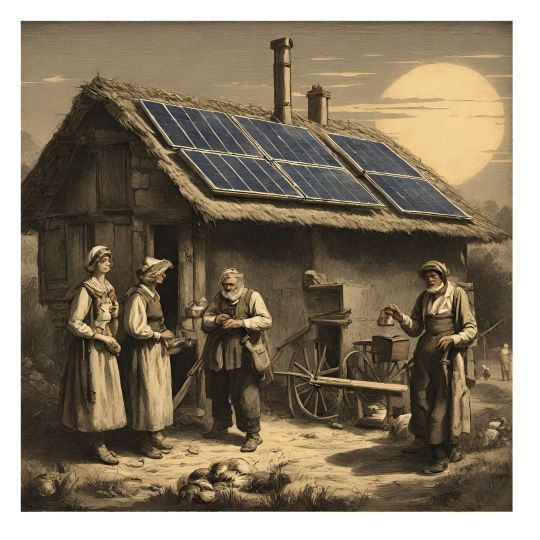
I hope you enjoy the above image. I entered some text into an AI image generator to "make" it.
and now, a story:
In 2019, I began working on a solar energy array to be installed on a property in Queens NY. The site was being developed as a low-income retirement community, and the developer was interested in adding a renewable energy system to the project.
The Brooklyn-based solar install company I was working for was selected to be the installer because the developer had an existing relationship with the solar company. But the developer didn’t want to run the solar scope, instead they made us be a subcontractor to the GC for all the work at the site.
This meant that the solar work had to be performed in compliance with the GC’s rules and requirements, as well as their obligations to all other parties in the Prime agreement.
Turns out there was a tinsy bit of federal HUD money funding the project (in addition to private equity and a couple big banks) which meant the project was subject to a whole raft of federal regulations, including Davis-Bacon prevailing wage requirements. (D-B PW)
Now, the solar company and I had experience with PW jobs, but not like this.
The GC’s labor compliance department had someone onsite every day tracking our guys clocking in and out, watching them take their breaks, and noting the various tasks they were performing.
Our payroll people had to submit certified payroll reports to the GC’s labor compliance people every week (we actually had to go from biweekly payroll to weekly for the whole company, because of this project).
Halfway through the install, we received a notice that some of the guys were doing work that fell under the ironworker classification in the D-B PW rates schedule.
What?!
The labor people thought they were doing the best job they could do in classifying the tasks they were seeing. Our guys spent 2 weeks bolting L-feet and aluminum extruded solar racking rail to the roof decking. Because the hardware was called “rail”, the labor people decided that our guys had to be paid like ironworkers.
This “opinion” and the resulting math meant that our crew of 5, working 8 hrs days, should have been paid $78 per hr, not $52. Suddenly, we had $10,000 in exposure to the GC related to labor underpayment. The GC was going to withhold this amount from payment to us for scope completed, unless we paid our guys the proper amount.
Well, we set about to correct the perception that ironworker was the correct classification.
This took a lot of research into the minutiae of the D-B PW regs, and more that a ridiculous amount of explanation about what solar rail is and how it is installed.
While we were able to make 'ironworker' go away, we weren’t in the clear. These classification issues and the related exposures would persist throughout the project.
Following Mechanical Completion, and on our way to Substantial, we got some bad news.
We had been paying our electricians $62 per hr for the work on the DC side of the inverters:
- Opening pallets, moving modules, bolting them to the racking, connecting the MC4s, terminating homerun wires, wire management, etc.
Labor compliance sent a notice that the proper rate for electricians was $116 per hr.
This was a $53,000 problem.
Turns out that in NYC, the union (Local 3 IBEW) had an agreement with the city to define solar install work on the DC side. They had amended the collective bargaining agreement with the NYC DOL in the last couple of years. The text defined the work and determined the proper rate was to be $62 per hr. That was the rate we were using.
But the federal DOL didn’t recognize this classification. In the D-B PW classification list, they only have one bucket for “Electrician”, and the rate is $116.
We were using the wrong PW rate schedule. The one we had always used in NYC wasn’t valid here. We had bid the project with a labor cost assuming NYC PW rates.
We went back to the contract documents, and sure enough, there was an exhibit that called out the Federal PW schedule.
This was a big problem.
We told the GC about the local PW rate, and why we were “underpaying” our guys. The GC realized the pain we were in, and offered to poke around to see if there was something that could be done. The GC told some contacts they had in the housing department in NYC.
The amazing housing people on Gold Street in NYC said they would support us in a petition to the Federal DOL to look at the situation and request a formal decision on the proper rate for this work.
We prepared the proper paperwork, and a letter outlining the situation. We even supplied, as an exhibit, the Local 3 amendment to the CBA that defines the solar install work and gives the rate.
Our letter basically said, “Hey DOL, there are over 250,000 people working in solar in the USA, and you don’t have a labor classification for the work they do. This labor rate for Electrician that you have covers all kinds of complicated work where knowledge of code is critical and the workers need training in using specialty tools. Solar is kinda more like putting sheets of plywood down on rafters and then running extension cords. It seems reasonable to take the position that you should recognize this other type of work as distinct and assign it a reasonable rate. Look, even the IBEW here in NYC acknowledges this. They already picked a rate. Can we pay our guys that number? “
The DOL wrote back, “Nope.”
We appealed.
They took another look at the situation and reported back. At this point, the project was almost done, and the GC was holding onto a lot of money that was requested in our G702 payment applications.
I have read that letter the DOL sent dozens of times (it is written in English), and I still do not understand their reasoning. But they did declare that they performed a work task analysis and evaluated the market conditions for similar comparable tasks in the trades. They even interviewed reps at the relevant unions to help constrain the range for the proper rate.
They arrived to a rate that complied with the federal rules related to how DOL runs this kind of analysis. They said we had to pay our people $84 per hr.
This wasn’t $57 per hr, and so we still had an underpayment issue. But it made the $53,000 problem into a $21,000 one.
Our contacts at NYC housing said this was a huge victory and we should be really proud of ourselves.
So now, whenever we bid a PW project in NYC, we ask to see the rate schedule, and we triple check to see if it is NYC PW rates, or Federal rates.
When it is Federal rates, we price our elec labor at $84 per hour ( we like living on the edge).
Then we get the notice of underpayment halfway through the project, with the citation that D-B PW says electricians should get $116 per hr.
Then we initiate a rate classification inquiry to the DOL, and we submit the letter we got from DOL in 2022 as an exhibit. “Hey, remember when you did a study on this exact matter and arrived to $84 per hr?” So far, it has worked out in our favor a couple times.
Our crew loves working on those jobs.
Sometimes, I wonder what the difference is between open shop rates, and local PW rates, and federal rates for other geographies.
I even once suggested to SEIA that they investigate this. Maybe in Southern California or Georgia or Illinois the difference between the federal D-B PW rate for electricians isn’t so high as in NYC. But maybe it is high enough that petitioning the DOL to make a bucket for solar installation would result in a few of millions of dollars in labor cost savings across dozens of projects. Reducing project costs by that kind of money would increase the amount of solar installed every year in this county.
I guess there just aren’t that many projects elsewhere in the states that are subject to federal D-B PW rates. Oh well.
Which brings me to “photovolfaic”
The original letter we got from DOL responding to our rate classification inquiry contained this typo in the critical section naming the Proposed Classification. The second letter from them referred to the first, so they used the same term. All subsequent letters and official correspondence from DOL have referred to the proposed classification as:
“Electrician-Solar Photovolfaic Systems”
( I guarantee that our original SF-1444 form sent to DOL contained the proper spelling in the field for “Proposed Classification Title”. )
I once called my contact at DOL to try to attempt to correct the misspelling, while being humble about “photovolfaic” being an unfamiliar term to me. She was firm that I needed to honor the classification defined by DOL and referenced in their letters.
Therefore, I have preserved the use of the term as they spelled it in every following letter.
It’s pretty silly. But my engagement with them requires me to be deferential. The power differential in this relationship has me perpetuating their error.
I fear that this matter will escalate to some senior labor official in the White House and we will end up catching a clip of Joe Biden on CNN talking about growth in “photovolfaics”.
Anyway, my co-workers and I joke that it is actually a real word, traceable back to Olde Englisċ, perhaps originating in a draft manuscript by Chaucer.
This idea became an image in my head that I couldn’t shake. So, I URL’ed over to an AI image generator and now I have this memento of the hundreds of hours I have spent dancing with the DOL about how much to pay the guys who lay the glass.
I hope you like it. Have a sunny day

0 notes
Text
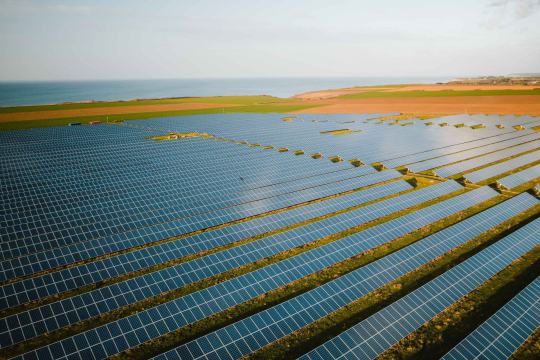
Agrivoltaics, agrivoltaics, agrivoltaics!
Article from Greentech Renewables here
Not only does the shade from the PV modules reduce water use for the crops, the presence of the crops cools the modules and increases energy generation.
The benefits (generically shown) of dual use on 2 hectares:
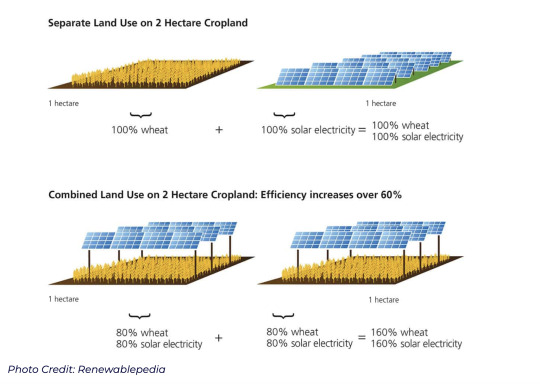
2 notes
·
View notes
Text
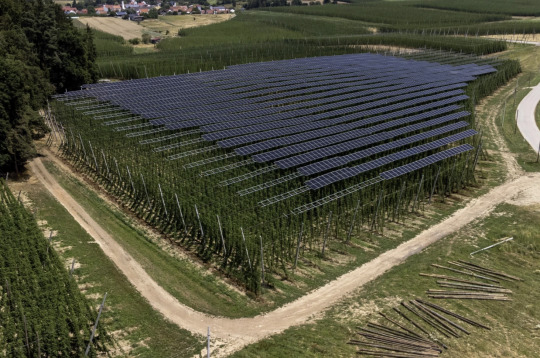
I love this PV array installation that has the solar panels 20 feet in the air, above a hops farm in Germany.
The panels keep the crops cooler, and reduce water use on the farm - up to 16% according to a research associate from the University of Sheffield.
Article link.
pic credit: AP Photo/Matthias Schrader
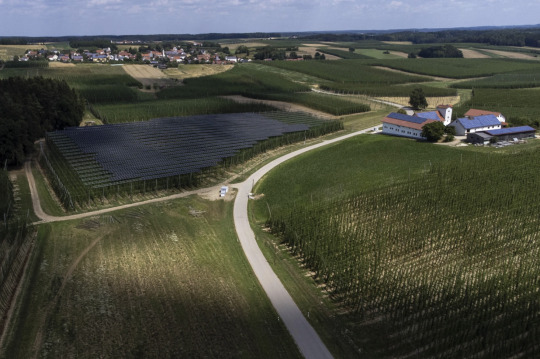
1 note
·
View note
Video
vimeo
Considering an indoor farm project? Check out this amazing tool from the people at Agritecture Consulting
3 notes
·
View notes
Photo

I just learned about this. So I am sharing it. This is a pic of the 1 MW prototype for the Beirut River Solar Snake project. Total project is targeting 10 MW of PV covering over 6 km of the river, with completion by 2020.
The system is generating 1,655 MWh/yrns per year.
The construction uses post-tensioned beams, so there are no support columns that make contact with the river.
project info here
more pics here
0 notes
Photo


789 ppm in the year 2100, that’s the buried lede in this article, by Zack Colman and Scott Waldman. The article’s headline: Trump admin sees grim climate outcome in car rule. That disastrous CO2 concentration is their prediction based on their proposed policy change to vehicle fuel efficiency standards.
I made this graph because I wanted to visualize what that meant, and my graph didn’t even have enough room to get to 789. Remember the grade school analogy about how adding CO2 to the atmosphere was like wrapping the earth in a blanket? When it is 90 degrees outside, and I’m in lying in bed trying to sleep, the last thing I want is a third down comforter draped over me.
How do we stop someone driving the car we are in, who is pointing towards misery and destruction and saying, “Yes, we are going to go in that direction, you cannot stop me.” ?
The other image is from NASA showing carbon dioxide being emitted across the globe, with the highest concentrations from megacities and wildfires in Africa.
4 notes
·
View notes
Photo

with digital currency mining, electricity is money.
just sharing a thought i had
check out this space heater that mines Etherium:

0 notes
Photo

Cool sculpture has been installed in the Harvard Forest.
There is an opening celebration this Saturday, Oct 7: from noon to 4 p.m.
more info here and here
I’m a big DBB fan. artist page
1 note
·
View note
Photo

If you are in the UK, you can get a solar + storage energy system from IKEA. I wonder if it comes with a little Allen key.
Solarcentury press release
IKEA solar page
photo credit Independent
0 notes
